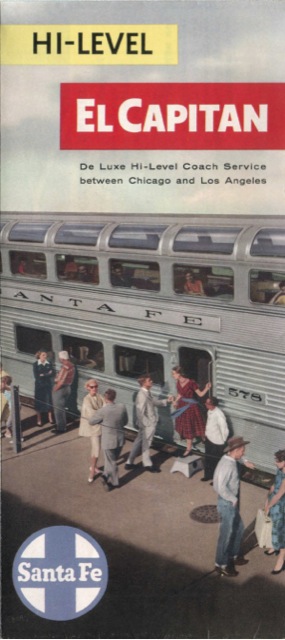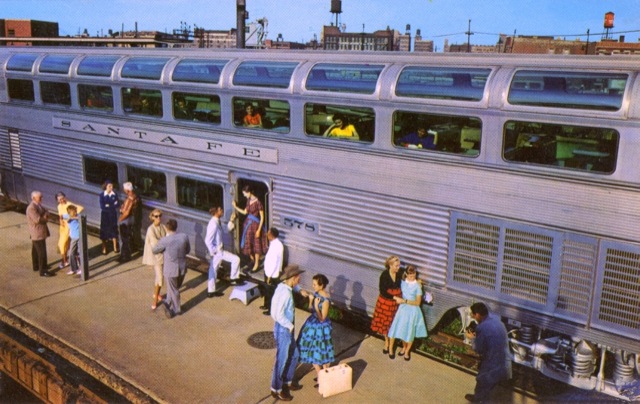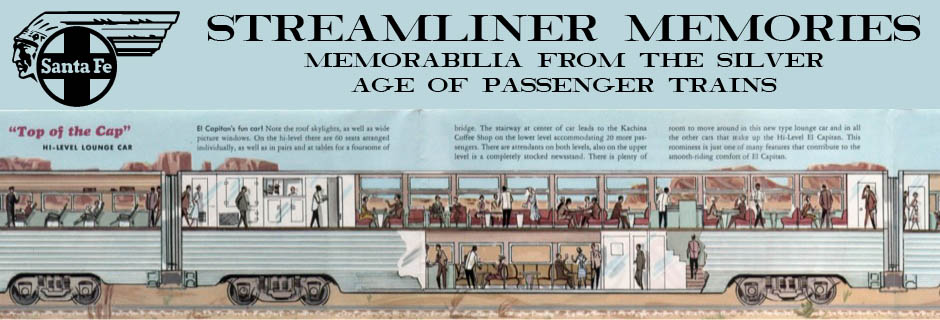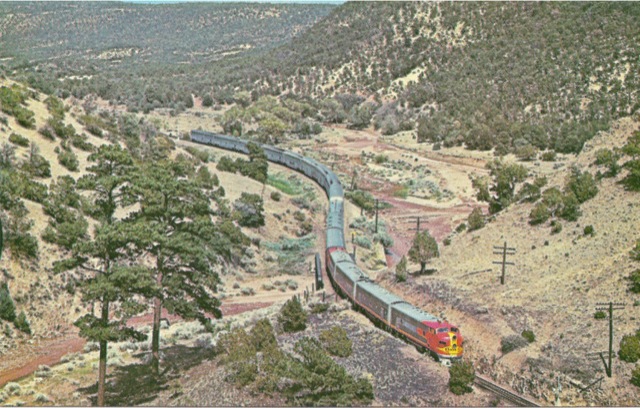On July 8, 1956, the Budd Company and the Santa Fe Railway wowed the railroad world by introducing a whole new kind of train: the Hi-Level El Capitan. Just 27 months after adding Big Domes to the El Capitan, the Santa Fe replaced the entire all-coach train with double-decked train cars, including coaches, a lounge car, and a diner. The Big Domes were bumped to the Chief.

Click image to download a 6.1-MB PDF of this brochure.
Budd had pioneered the construction of double-decked rail cars when it built the first bi-level commuter cars for the Burlington in 1950. The Milwaukee Road and Rock Island bought bi-level cars from Budd, while the Chicago & North Western and Southern Pacific bought simiiar cars from Pullman and St. Louis Car Company, all for commuter traffic in and out of Chicago or San Francisco.
In 1952, Budd suggested applying the concept of bi-level cars to intercity trains, and the Santa Fe ordered two cars. The cars, which had a stairway on one end so they could connect with conventional cars, were delivered in 1954 and tested on the El Capitan. They were not considered bi-levels as revenue seats were only on the upper deck; like the Big Domes, the lower deck, which had rest rooms and baggage racks, was lowered between the trucks, requiring only a small step to get on or off the train from the center doors.
After ten months of testing, Santa Fe ordered 47 more cars, enough to make up five nine-car trains with a few extra as spares. The order included 10 more “step-down” cars to allow a transition from conventional to hi-level cars; 25 coaches; 6 diners; and 6 lounge cars. Budd also added a fairing to existing crew dormitory cars to maintain a streamlined appearance throughout the train. The train wasn’t fully streamlined, however, in that it didn’t have a round-tailed observation car.
The previous El Capitan normally operated with seven or eight 44-seat coaches for a total capacity of about 350 revenue passengers. The hi-level coaches had 72 seats, all of them upstairs, while the step-down coaches had 68. The lower portions of the coaches were dedicated to luggage racks, spacious restrooms, and–over the wheels–electrical and air conditioning equipment. The Santa Fe normally put a step-down coach at each end of the train and put five regular coaches in-between, for a total capacity of nearly 500 revenue passengers.
The dining and lounge cars also had much higher than normal capacities. The diners had the kitchens downstairs and room for 80 people upstairs. The lounge cars had a newsstand and bar at one end and 60 seats upstairs, plus 20 more seats and a coffee shop downstairs.

A postcard based on this publicity photo calls this the “hi-level dome car of [the] El Capitan.” Although the lounge cars had center doors, they were normally used only for loading food and other items sold in the lounge, not for letting passengers on and off. Click image for a larger view.
The lounge car windows wrapped around the roof of the car, leading Santa Fe to advertise them as dome cars. They weren’t really domes because you couldn’t see in front or behind you, but they did offer nice views.
At just over 81 tons, the hi-level coaches were considerably lighter than a Santa Fe Big Dome, which at 93 tons required six-wheel trucks. Except for the hi-level diners, which weighed more than 104 tons, the hi-level cars needed only four-wheel trucks. The coaches each cost $275,000 (about $2.3 million in today’s dollars); the diners and lounge cars must have cost a little more.
The El Capitan in New Mexico. The car with the fairing is facing the camera. Click image for a larger view.
Two big advantages of the hi-level cars were the lower weights per seat and the lower costs of labor. A conventional 44-seat coach used on the previous El Capitan weighed close to 2,600 pounds per seat, while the hi-level coaches weighed about 2,300 pounds per seat. Both kinds of cars required one coach attendant, but with 60 percent more seats, that effectively meant nearly 40 percent lower labor costs per seat.
The hi-level concept was successful enough that Santa Fe ordered 24 more coaches (half of them step-down cars) from Budd in 1963, applying some to the San Francisco Chief. But hi-level sleeping cars designed by Budd were never built, and passenger ridership was declining too rapidly for other pre-Amtrak railroads to adopt the concept to their intercity trains.


I washed dishes (formally 4th cook) on El Capitan during the summer of 1969. Very interesting. We dishwashers had stainless steel all around us, and got dirty dishes in a dumbwaiter from the upper level. We stood on duck boards (think heavy duty pallets) and had a drain in the center of the stainless steel floor below the duck boards. On some of the dining cars the drain was still curved, to match the streamlining. On a few others, the curve wasn’t there, and one could look down and see the sunlight on the tracks in the daytime. That simple connection to the outside world made a huge difference in the quality of the trip.
Think about it. 500+ passengers on the train with a dining car that held 70 or so. Even though breakfast was the least popular meal, we turned the tables 3 or 4 times. At lunch and dinner it was 5 or 6 or more times.
In the dormitory car the bunks were 3 high, and about 6’2″ long. There were always a few cooks or waiters that were taller than that, and had been sleeping in those short bunks for years. We (the two fourth cooks) got a quarter a piece from them every morning, as it was our job to make up the beds in the dorm, too.
It was a great summer!